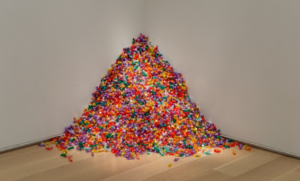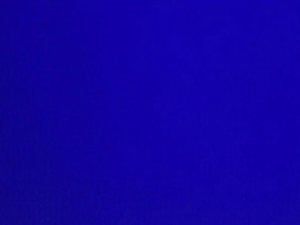“Embodied knowledge, while often denigrated and disavowed within the modern colonial episteme, confirms that Western scientistic validity comprises only one kind of knowing. Manifest through poetics, aesthetics, and other bodily attunements, sensuous knowledges open to alternative modes of relation. […] A sensory, embodied, affective, and imaginative relation to the world opens to a different kind of ethics and politics.”

Jenna Carine Ashton’s statement is interesting in relation to how Blue may be conceived within a gallery setting. From Watching Blue, I believe these is a congruity between the visual and what we hear but this visual element is more reliant and conditional upon the voice we hear. With the varying tones of voice, sounds and music, and heavy use of metaphor within the content of speech, the visual may act as a backdrop for these ‘stories and imaginative images to be projected onto the blue square quite meditatively. The emotional context of the piece, when learnt, offers insight into why the blue visual is there, and in turn adds much complicity when listening/viewing within a gallery or any public space. This is easy to say as I have just watched this wearing my cosiest jumper, hot water bottle and eating overnight oats; the sounds people make, what they say around me, or facial expressions are not there to be witnessed, making it much easier to look away or move around on my swivel chair. As he begins to whisper, I begin to lean into my laptop even though I can clearly understand what is being said. I believe this is down to the diaristic (through both words and sound) nature of the content which is inviting a response from us as if having a live conversation where we should have input and thoughts. I also think about the use of pauses by Derek Jarman and if this changes how the visual aspect of Blue is perceived. These give us time to ‘look’, reflect, and anticipate what will come next.
Felix Gonzalez-Torres offers a more momentary interaction with an audience with Untitled (Portrait of Ross in LA), which offers a pile of candy at 175 lbs (healthy average weight for a man) that people can take and the gallery keeps adding to. As this candy is taken, the shape, outline and weight of the overall pile of candy diminishes and would need to be added to, to keep the work alive and going. This change in weight and form is reflective of Gonzalez-Torres’ partner who died of AIDS and equates this participation to the change in form; vital to the artwork and its meaning. From multiple people taking this candy we can then see drastic changes to the piece overtime, whereas Blue is more of an immediate and forward way of interacting

https://www.artic.edu/artworks/152961/untitled-portrait-of-ross-in-l-a

Blue, Derek Jarman, 1993

Leave a Reply